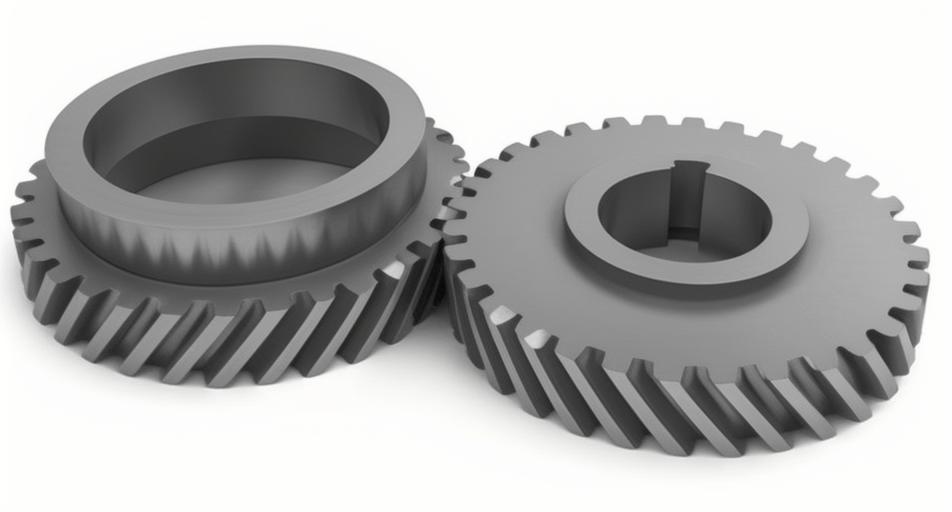
Helical gear is widely used in modern machinery due to their unique design and superior performance characteristics. Here are some of the key advantages of helical gear:
1. Smooth and Quiet Operation
Characteristics:
- Helical gear has teeth that are cut at an angle to the face of the gear.
- This design allows for gradual engagement of the teeth, resulting in smoother and quieter operation compared to spur gear.
Advantages:
- Reduced Noise: The gradual engagement and multiple tooth contact significantly reduce the noise generated during operation.
- Smooth Power Transmission: The helical design ensures continuous contact between teeth, leading to smoother power transmission with less vibration and shock loads.
Applications:
- Ideal for applications requiring low noise and smooth operation, such as automotive transmissions, elevators, and conveyor systems.
2. Higher Load Carrying Capacity
Characteristics:
- The angled teeth of helical gear allow for more teeth to be in contact at any given time.
- This increases the surface area over which the load is distributed.
Advantages:
- Enhanced Load Distribution: Multiple teeth in contact reduce the stress on individual teeth, allowing the gear to carry higher loads.
- Greater Durability: The load-sharing capability reduces wear and tear, extending the lifespan of helical gear.
Applications:
- Suitable for heavy-duty applications, such as industrial machinery, mining equipment, and high-performance automotive systems.
3. High Efficiency
Characteristics:
- Helical gear is designed to mesh more precisely than spur gear, leading to better efficiency in power transmission.
- The inclined angle of the teeth facilitates smoother motion with less energy loss.
Advantages:
- Improved Mechanical Efficiency: The precise meshing and reduced friction result in higher efficiency in power transfer.
- Energy Savings: Efficient operation reduces energy consumption, leading to cost savings over time.
Applications:
- Frequently used in applications where energy efficiency is critical, such as electric vehicles, robotics, and renewable energy systems.
4. Versatility and Flexibility
Characteristics:
- Helical gear can be designed to operate at various angles, including parallel and crossed configurations.
- They can transmit motion and power between non-parallel shafts.
Advantages:
- Flexible Design Options: The ability to work at different angles provides greater design flexibility for complex machinery.
- Compact Gear Systems: Helical gear can be used to create compact and efficient gear systems with various shaft orientations.
Applications:
- Common in applications requiring compact and versatile helical gear arrangements, such as packaging machinery, aerospace systems, and automated production lines.
5. Reduced Wear and Tear
Characteristics:
- The gradual engagement and continuous contact of helical gear teeth reduce the impact and stress on individual teeth.
- This leads to lower wear and tear compared to helical gear with direct engagement.
Advantages:
- Longevity: Reduced stress and impact extend the operational life of helical gear.
- Lower Maintenance Costs: Fewer breakdowns and lower wear result in decreased maintenance requirements and costs.
Applications:
- Suitable for applications where longevity and low maintenance are essential, such as in HVAC systems, wind turbines, and marine applications.
6. Axial Thrust Management
Characteristics:
- Helical gear generate axial thrust due to the angled teeth, which needs to be managed in the design and operation of gear systems.
Advantages:
- Controlled Axial Load: Proper design and the use of thrust bearings can manage axial loads effectively, enhancing overall helical gear performance.
- Application Specific Adjustments: The ability to control and manage axial thrust allows for customization based on specific application requirements.
Applications:
- Used in applications where axial load can be effectively managed and leveraged, such as in automotive gearboxes and heavy machinery.
Conclusion
Helical gear offer significant advantages in modern machinery, including smooth and quiet operation, higher load-carrying capacity, high efficiency, versatility, reduced wear and tear, and effective management of axial thrust. These benefits make helical gear a preferred choice in various industries, from automotive and aerospace to industrial machinery and renewable energy systems. Their ability to provide reliable, efficient, and durable performance makes them integral to the advancement of modern technology and machinery.
